Rationale
The purpose of the study is to determine to what extent note taking through visual or graphic with a kinesthetic integration (foldables) have on students’ self-efficacy of third grade level mathconcepts. The researcher in this study and her colleagues found that there were learning gaps intheir students’ understanding of math concepts with solely the use of the school’s math adopted program. Thus, the researchers sought to add additional math learning resources to the curriculum. Additionally, the researchers in this study and her colleagues felt that third grade students were not exposed to note taking opportunities as frequently as the researcher would recommend. The practice of note taking through visual or graphic with a kinesthetic integration will allow for more note-taking opportunities for the students. Finally, the researcher is hoping the use of foldables will reach more kinesthetic learners through a hands-on approach to learning. The researchers hope that if this is found to be effective in the classroom, other grade levels will include these strategies within their math instruction.
Context
The lab school is located on the campus of Florida Atlantic University. There are 1,205 students enrolled at the school. The racial backgrounds of the students include: 43.4% White, 26.7% Hispanic, 14.9% African American, 10.0% Asian, 4.6% two or more races, 0.3% American Indian, and 0.1% Pacific Islander. There are 41 students participating in the study. Of those 41 students, six of the students are receiving ESE services, and one student is an English Language Learner. Study consent will be received from both the participants and their parents. The 61 students are in two general education third grade classrooms in class sizes of 20-21 students. The students have daily access to individually assigned chromebooks, and classroom work materials.
Supportive Literature
While many could argue the appropriate age or grade to learn note taking skills; it is a skill that needs to be learned, taught and modeled. Evidence has been found that graphic organizers, including foldables, can be used in a wide range of content areas, from science, math, reading as well as varying levels of education from elementary school to advanced high school courses (Ayverdi et al., 2014; Purcell, 2014; Vivian & Wisker, 2008). While much research exists on the benefit of foldables in reading and content areas such as science and social studies (Vivian & Wisker, 2008; Purcell, 2014; Ayverdi et al., 2014), there is little evidence on the effects of note taking through graphic organizers and foldables in math. One of the main benefits of using graphic organizers and foldables is students’ retention of content information and how these note taking strategies help students to better understand complex topics. The study of previous research explains that these benefits are due to many factors, such as helping students to organize and visualize content. Finally, the success of foldables and graphic organizers is due to their ability to support student ownership in their work. Fisher and Frey (2018) best described the benefit of foldables and graphic organizers by saying “we can increase the likelihood that students will take pride in their work when we use graphic organizers to facilitate students’ thinking about the content they are learning (p.766).” The tangible aspect of foldables allow students to take ownership of their notes, as well as be creative.
Research Methods
Throughout this process we surveyed students on their preferences of learning with the various tools as well as their perceptions of the effectiveness of the various tools we implemented. We introduced students to a new skill, providing opportunities for productive struggle, moved into conceptual understanding as well as cooperative learning opportunities. As students began to strengthen and deepen their skills, we would move to more abstract concepts. After each topic the students would take a survey that asked how they felt about the foldable they were using and asked to rank all the mathematical tools used within the unit.
Additionally, we kept a journal of our observations of the students using, and responding to the math foldables as well as when they completed the surveys. Within this journal we noted student reactions to the various math activities. We also wrote quotes from students as they participated in the activities. Finally, we also made note of student engagement.
Data collected within this study was analyzed quantitatively and qualitatively. We reviewed the survey responses looking at various angles of the data. We particularly focused on the math tool preference question, as well as how helpful the student found the tools. For qualitative data, we reviewed our journals, looking for quotes that aligned with the quantitative data, as well as any outlying quotes from students.
Results
Students ranked the various tools we use in math instruction on a 1-4 scale, with 1 being their preferred and most useful tool. Our first finding was that manipulatives (hands on tools such as counters, fraction bars, various hands on math games) ranked a 1.9 showing that students highly favored this as a math learning tool along with computers, 2.1. On the other hand, the textbook had an average score of 3.2 and was most often ranked 4th (last) in the student surveys. It was observed by the researchers that when students were told we would be working in their math notebooks for the lesson, there was always audible joy throughout the classroom. The researchers noted that a student said, “Manipulatives are cool because sometimes they are like puzzles and putting the pieces together is exciting.” However one student said “I don’t like gluing and cutting, I'm not a big art guy- but I feel like they help me learn and they help me on the test” This statement indicated that the student may not have enjoyed the manipulatives, notebooks, etc. however they realized that they were beneficial in their learning. Other students expressed they enjoyed getting to cut and paste- something not done in the intermediate grades as often as in the primary grades.

Secondly, students noted on the surveys how they found the foldables and notebooks to be most impactful to their learning. The data from the surveys shows that the students found the notebook to be the most useful during the test, and closely second- in preparation for the test. In agreement with this data, the researchers noted a student saying that they feel that they learn more through using the math notebook because they refer back to it later if needed. Another student said “I like using foldables when learning math because it makes it fun especially when the foldable has flaps, they are so cool”. This statement shows that students enjoy the foldables as a tool to learn the material, a choice we did not include as an option on our impact question on the survey.

Implications
It should be noted that this group of Third Graders experienced the Pandemic as a
Kindergartener. They went to virtual learning halfway through their Kindergarten school year. A number of the students remained a virtual learner through their entire First Grade year and did not come back to in person instructions until Second Grade. During their second grade year a number of rules/regulations were put into place within the school system and students continued to remain separated with distance between individuals as well as individual supplies (no community use). As the students progressed into their school year, this was the first “regular” school year in which students were able to emerge themselves in a typical classroom setting with partner working, touching of supplies (manipulatives, supplies, etc.). The researchers found that with the pandemic set back, students did not have the opportunities for hands-on learning, hence dropping student achievement/math concepts mastery causing mathematical gaps. With that being said, we wanted to rebuild the student’s love for math and bring back excitement within the classroom. As previously mentioned, research has shown that high student engagement leads to student success and the closing of gaps in learning. The results from this study support this testament.
Educators should note that our study found that the use of foldables in mathematics
showed high interest amongst the students and heightened students’ confidence in themselves as well. Additionally, it was our hope that the students would use these foldables as a study tool, and as a resource during assessments. It was found that this is how the students found the foldables to be the most impactful to their learning. Moving forward, educators of math should consider incorporating additional hands-on learning tools into their curriculum.
References
Ayverdi, L., Nakiboğlu, C., & Aydin, S. Ö. (2014). Usage of graphic organizers in science and technology lessons. Procedia-Social and Behavioral Sciences, 116, 4264-4269.
Fisher, D., & Frey, N. (2018). The uses and misuses of graphic organizers in content area learning. The Reading Teacher, 71(6), 763-766.
Purcell, J. (2014). Creating memorable learning experiences with foldables in ap human geography. The Geography Teacher, 11(4), 129–134. https://doi.org/10.1080/19338341.2014.975148
Vivian, R. M., & Wisker, N. F. (2008). Using foldables in the classroom. STEM, 1-8.
